美国FDA药物分析程序及方法验证指导原则(中文版)
美国食品药品监督管理局复方制剂非临床安全性评价指导原则介绍
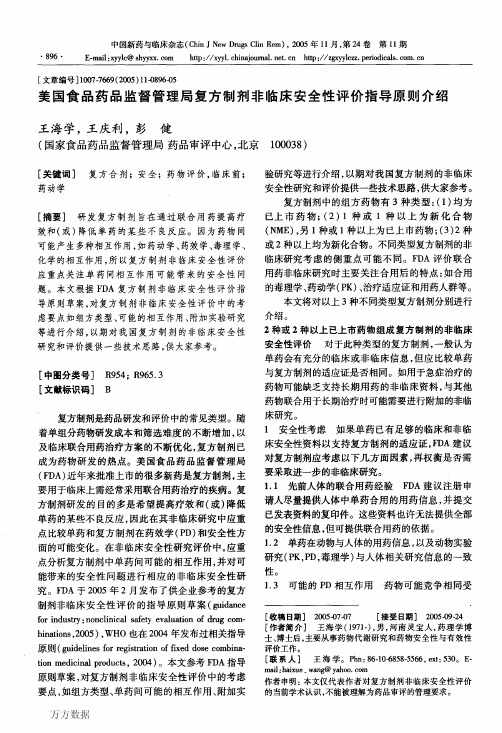
E-mail:xyylc@shyyxx.conlhttp://xyyl.chinajournal.net.cnhttp://zgxyylczz.periodicals.com.cn。
897・体或具有相似生理功能。
1.4可能的PK相互作用药动学相互作用的产生可能有多种方式,有些可以在体内进行监测而有些则不能。
一个药物可能改变另一个药物的吸收、排泄、组织分布,或改变代谢类型或速率。
药物也可能竞争性结合血浆蛋白,引起某个药物的游离型浓度升高和组织分布增加。
1.5毒理学的相互作用若单药的毒性靶器官相似,复方制剂中单药的无毒剂量会降低或单药对毒性靶器官的毒性会增强。
FDA建议关注单药的全部毒理学信息[如一般毒性、生殖毒性、致癌性和安全药理学(心血管、中枢神经系统和呼吸系统)]。
1.6单药的安全范围如果某一单药的安全范围较窄,在临床治疗的暴露水平存在严重毒性,应特别关注单药间的相互作用,尤其当毒性是不可逆或在临床无法进行监测时。
1.7可能竞争或改变同一酶或其他细胞内分子内源物质的水平或活性,如2个氧化剂同时给药可能导致内源性谷胱甘肽的耗竭。
1.8可能的化学相互作用一个药物可能化学修饰另一个药物(如一个药物可能氧化、甲基化、乙酰化另一个药物),这可能会产生新化合物(可能产生新的毒性)。
1.9一个药物可能影响另一个治疗急症药物的有效性。
2非临床研究建议某些情况下,复方制剂中单药及联合用药均有足够的临床用药信息,此时再要求进行非临床研究可能是不必要的。
例如,治疗人类免疫缺陷病毒(HIV)的药物研究指导原则中指出,以前已被批准用于治疗HIV病人的药物用于复方制剂时可不要求进行体外的实验研究,因为联合用药的有效性和安全性已经在临床得到评价,或在药品说明书中介绍过,或已有研究文献报道。
2个或2个以上药物联合用药时,若复方制剂具有足够的临床用药信息,对此类复方制剂进行申报,建议注册申请人与审评相关部门讨论是否需要进行其他的非临床安全性评价。
CMC审评_科学加风险的综合评估_美国FDACDER新药质量审评部简介

41Journal of China Prescription Drug 2009.3 No.84——美国FDA CDER新药质量审评部简介Meheb Nasr 博士 汤玉冰 博士ONDQA持续不断的致力于寻求多种方式以进一步推动科学与风险综合评估举措进入审评规范,改进审评效率,应用最先进的科学手段应对突发事件,以及鼓励药厂运用质量源于设计的原理进行药品质量管理。
除非处方药典药(O T C monograph drugs)及临床试验药(Investigational New Drugs,IND)以外,在美国上市的所有新药都必须遵守美国相关新药申请(New Drug Application)法规,事先接受美国食品药品管理局(US Food and Drug Administration,FDA)的审理并取得其批准。
FDA 下属的化学类药物评价与研究中心(Center for Drug Evaluation and Research,CDER)是其属下的五个中心之一。
此中心的职责为审评并批准申请在美上市的化学类药品及某些生物类药品的安全性、有效性及质量可控性。
新药申请材料中相当一部分涉及药品的药物化学、药品生产以及生产和质量监控(Chemistry,Manufacture and Control,CMC)。
而这部分的审评则为CDER 下属的新药质量评审部(Office of New Drug Quality Assessment,ONDQA)的主要职责,生物药品的这部分则属于生物科技产品部的职责。
需要补充说明的是国际会议协调组织(International Conference Harmonization,I C H )将C M C 部分统称为质量CMC 审评:科学加风险的综合评估专家简介Moheb Nasr博士为本文英文作者,现为美国FDA药物评审与研究中心(CDER)新药质量评审办公室主任。
负责审查药品的化学、生产与控制(CMC)的属性。
FDA对原料药检查的流程
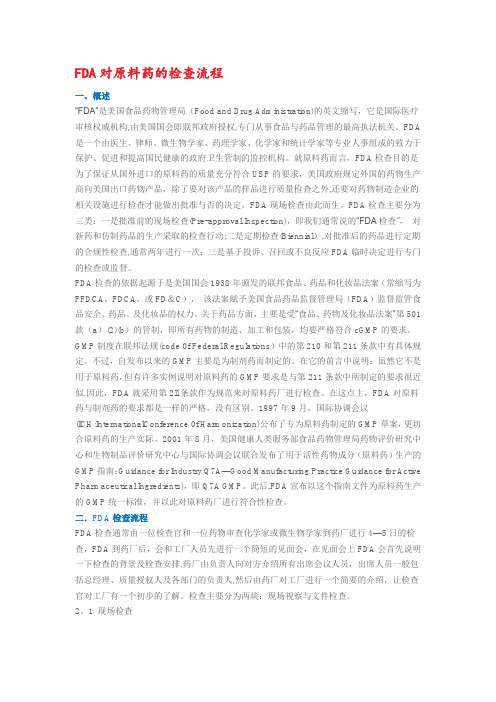
FDA对原料药的检查流程一、概述“FDA”是美国食品药物管理局(Food and Drug Administration)的英文缩写,它是国际医疗审核权威机构,由美国国会即联邦政府授权,专门从事食品与药品管理的最高执法机关。
FDA 是一个由医生、律师、微生物学家、药理学家、化学家和统计学家等专业人事组成的致力于保护、促进和提高国民健康的政府卫生管制的监控机构。
就原料药而言,FDA检查目的是为了保证从国外进口的原料药的质量充分符合USP的要求,美国政府规定外国的药物生产商向美国出口药物产品,除了要对该产品的样品进行质量检查之外,还要对药物制造企业的相关设施进行检查才能做出批准与否的决定,FDA现场检查由此而生。
FDA检查主要分为三类:一是批准前的现场检查(Pre-approval Inspection),即我们通常说的“FDA检查",对新药和仿制药品的生产采取的检查行动;二是定期检查(Biennial),对批准后的药品进行定期的合规性检查,通常两年进行一次;三是基于投诉、召回或不良反应FDA临时决定进行专门的检查或监督。
FDA检查的依据起源于是美国国会1938年颁发的联邦食品、药品和化妆品法案(常缩写为FFDCA,FDCA,或FD&C),该法案赋予美国食品药品监督管理局(FDA)监督监管食品安全、药品、及化妆品的权力。
关于药品方面,主要是受“食品、药物及化妆品法案”第501款(a)(2)(b)的管制,即所有药物的制造、加工和包装,均要严格符合cGMP的要求。
GMP制度在联邦法规(code 0f Federal Regulations)中的第210和第211条款中有具体规定。
不过,自发布以来的GMP主要是为制剂药而制定的。
在它的前言中说明:虽然它不是用于原料药,但有许多实例说明对原料药的GMP要求是与第211条款中所制定的要求很近似.因此,FDA就采用第2ll条款作为规范来对原料药厂进行检查。
美国FDA药物分析程序及方法验证指导原则(中文版)
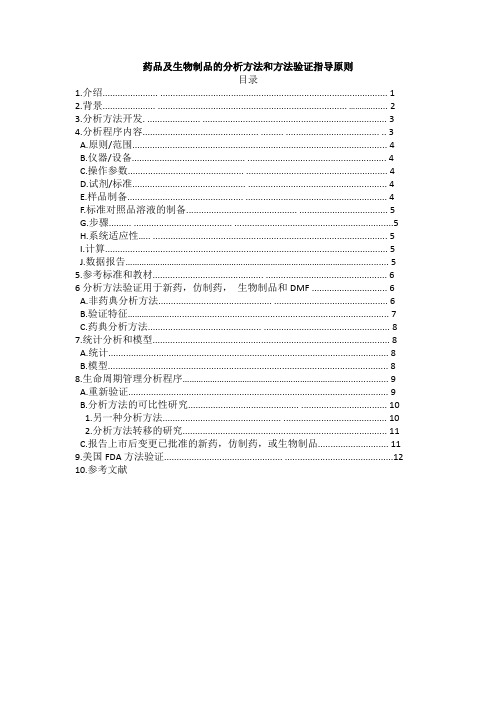
药品及生物制品的分析方法和方法验证指导原则目录1.介绍...................... (1)2.背景..................... .. (2)3.分析方法开发. ..................... . (3)4.分析程序内容.............................................. ......... ..................................... .. 3A.原则/范围 (4)B.仪器/设备............................................. . (4)C.操作参数.............................................. .. (4)D.试剂/标准............................................. . (4)E.样品制备.............................................. .. (4)F.标准对照品溶液的制备............................................ .. (5)G.步骤......... ....................................... (5)H.系统适应性..... (5)I.计算 (5)J.数据报告 (5)5.参考标准和教材............................................ (6)6分析方法验证用于新药,仿制药,生物制品和DMF (6)A.非药典分析方法............................................. (6)B.验证特征 (7)C.药典分析方法............................................. .. (8)7.统计分析和模型 (8)A.统计 (8)B.模型 (8)8.生命周期管理分析程序 (9)A.重新验证 (9)B.分析方法的可比性研究............................................ . (10)1.另一种分析方法............................................... .. (10)2.分析方法转移的研究 (11)C.报告上市后变更已批准的新药,仿制药,或生物制品 (11)9.美国FDA方法验证............................................... . (12)10.参考文献前言本指导原则草案,定稿后,将代表美国食品和药物管理局(FDA)目前关于这个话题目前的想法。
美国药典溶出度试验方法的建立与验证指导原则的解读

小结
➢注重实操,关注细节。 ➢认真验证,数据为优。 ➢逻辑缜密,有理有节。 ➢宽容有度,得心应手。
重点关注
1、溶出的目的 2、造成溶出差异的因素
➢ 样品(是我们想知道,想找出的) ➢ 试验(是不想要的,应降到最低)
3、目测检视 4、方法学验证
谢谢!
溶出度与释放度的方法学验证
准确度
溶液稳 定性
专属性
验证 项目
耐用性
线性范 围
精密度
测定方法与验证-方法学验证
专属性
胶囊
辅料与其他 活性成分
沉降篮
干扰来自何方?如何除去干扰?
测定方法与验证-方法学验证
专属性应注意的问题
• 空白包括:其他活性成分(复方制剂中)、 辅料、包衣、油墨、沉降篮、胶囊壳、装 置(桨、杆、篮)等。
自动取 样
对比验证 内容
试验设计
取样应注意的问题
➢ 手动取样与自动取样要进行比较验证 ➢ 自动取样应注意日常性能检查和维护 ➢ 自动取样的装置要注意对溶出杯中流体力学的
干扰。 ➢ 自动取样的验证还包括:
残留药物的扣减 药物的吸附 洗涤或循环洗涤
试验设计
滤膜吸附及验证
滤过与离心
滤膜吸附的考察
滤膜吸附的验证
美国药典溶出度试验 方法的建立与验证指
导原则的解读
2017.6.30
涵盖内容
▪ 总体评价 ▪ 溶出介质 ▪ 溶出仪器 ▪ 实验设计 ▪ 测定方法与验证
总体评价
限度 范围
区分 力
总体 评价
稳定 性
变异 范围
总体评价-限度
▪ 限度范围应考虑的问题
1、多批次的考量 2、具有代表性 3、具有针对性(针对重点药品) 4、考虑样品的稳定性
翻译(SUPAC-IR指导原则:速释口服固体制剂:放大生产和批准后变更)
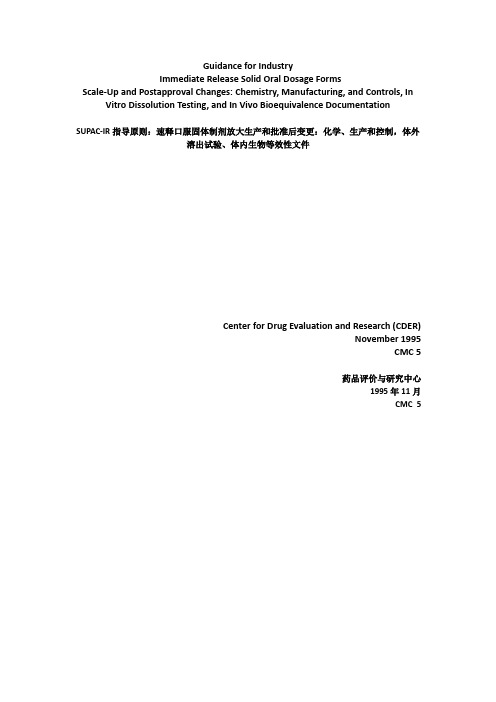
Guidance for IndustryImmediate Release Solid Oral Dosage FormsScale-Up and Postapproval Changes: Chemistry, Manufacturing, and Controls, In Vitro Dissolution Testing, and In Vivo Bioequivalence DocumentationSUPAC-IR指导原则:速释口服固体制剂放大生产和批准后变更:化学、生产和控制,体外溶出试验、体内生物等效性文件Center for Drug Evaluation and Research (CDER)November 1995CMC 5药品评价与研究中心1995年11月CMC 5TABLE OF CONTENTS目录I. PURPOSE OF GUIDANCE (本指导原则的目的). . . . . . . . . . . . . . . . . . . . . . . . . .. . . . . . . . . . . . 1 II. DEFINITION OF TERMS(术语定义). . . . . . . . . . . . . . . . . . . . . . . . . . . . . . . . . . . . . . . . . . . . . .. 3 PONENTS AND COMPOSITION(辅料成分或组成的变更). . . . . . . . . . . . . . . . . . . . . . . . .. 6 IV. SITE CHANGES(地点变更). . . . . . . . . . . . . . . . . . . . . . . . . . . . . . . . . . . . . . . . . . . . . . . . . . . . .. 13 V. CHANGES IN BATCH SIZE (SCALE-UP/SCALE-DOWN)(批量大小(放大/缩小)的变更). .. . . . 16 VI. MANUFACTURING(生产变更). . . . . . . . . . . . . . . . . .. . . . . . . . . . . . . . . . . . . . . . . . . . . . . . . . . 18 VII. IN VITRO DISSOLUTION (体外溶出试验). . . . .. . . . . . . . . . . . . . . . . . . . . . . . . . . . . . . . . . . . . 23 VIII. IN VIVO BIOEQUIVALENCE STUDIES (体内生物等效性). . . . . . . . . . . . . . . . . . . . . . . . . . . . . 23 IX. REFERENCES(参考文献). . . . . . . . . . . . . . . . . . . . . . . . . . . . . . . . . . . . . . . . . . . . . . . . . . . . . . 25 APPENDIX A: NARROW THERAPEUTIC RANGE DRUGS(附录A:治疗窗狭窄药物). . . . . . . . . A-1GUIDANCE FOR INDUSTRY 1IMMEDIATE RELEASE SOLID ORAL DOSAGE FORMS SCALE-UP AND POSTAPPROVAL CHANGES: CHEMISTRY, MANUFACTURING, AND CONTROLS, IN VITRO DISSOLUTION TESTING, AND IN VIVO BIOEQUIVALENCE DOCUMENTATION速释口服固体制剂放大生产和批准后变更:化学、生产和控制,体外溶出试验、体内生物等效性文件I. PURPOSE OF GUIDANCE(本指导原则的目的)This guidance provides recommendations to sponsors of new drug applications (NDA's), abbreviated new drug applications (ANDA's), and abbreviated antibiotic applications (AADA's) who intend, during the postapproval period, to change: 1) the components or composition; 2) the site of manufacture; 3) the scale-up/scale-down of manufacture; and/or 4) the manufacturing (process and equipment) of an immediate release oral formulation.本指导原则所提供的的建议适用于新药申请(NDA's)、仿制药申请(ANDA's)和抗生素仿制药申请(AANA’S)的企业的批准后变更,内容包括:1)成分或组分的变更;2)生产地点的变更;3)放大/缩小生产规模的变更;和/或4)生产过程(工艺和设备)的变更This guidance is the result of: 1) a workshop on the scale-up of immediate release drug products conducted by the American Association of Pharmaceutical Scientists in conjunction with the United States Pharmacopoeial Convention and the Food and Drug Administration (FDA); 2) research conducted by the University of Maryland at Baltimore on the chemistry, manufacturing and controls of immediate release drug products under the FDA/University of Maryland Manufacturing Research Contract; 3) the drug categorization research conducted at the University of Michigan and the University of Uppsala on the permeability of drug substances; and 4) the Scale-Up and Post Approval Changes (SUPAC) Task Force which was established by the Center for Drug Evaluation and Research (CDER) Chemistry, Manufacturing and Controls Coordinating Committee to develop guidance on scale-up and other postapproval changes.本指导原则是以下工作的成果:1)在美国药学科学家协会与美国药典委员会和FDA的指导下,进行速释药品放大生产的车间;2)在位于巴尔的摩的马里兰大学指导下,并在FDA/马里兰大学生产研究合同下的速释药品的化学、生产和控制的研究;3)在密歇根大学和乌普萨拉大学指导下的药品分类学研究中关于药物渗透性的研究;4)由药品评价和研究中心(CDER)化学、生产和控制协调委员会成立的放大生产和批准后变更(SUPAC)特别小组,来制定关于放大生产和其它的批准后变更的指导原则。
FDA最新指导原则:药物分析程序及方法验证指导原则
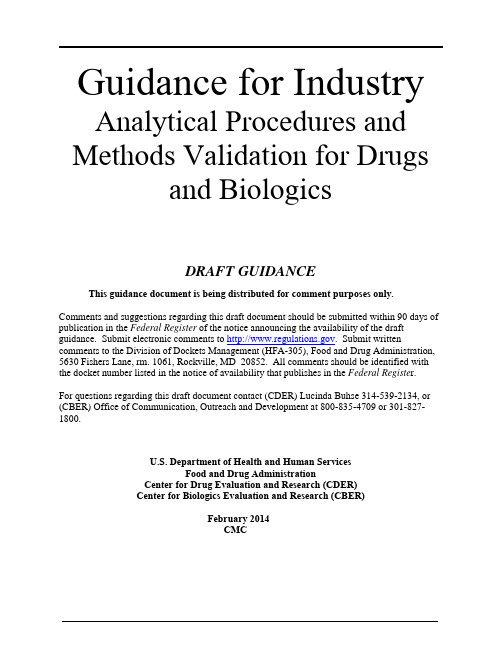
Analytical Procedures and Methods Validation for Drugsand BiologicsDRAFT GUIDANCEThis guidance document is being distributed for comment purposes only. Comments and suggestions regarding this draft document should be submitted within 90 days of publication in the Federal Register of the notice announcing the availability of the draft guidance. Submit electronic comments to . Submit written comments to the Division of Dockets Management (HFA-305), Food and Drug Administration, 5630 Fishers Lane, rm. 1061, Rockville, MD 20852. All comments should be identified with the docket number listed in the notice of availability that publishes in the Federal Registe r.For questions regarding this draft document contact (CDER) Lucinda Buhse 314-539-2134, or (CBER) Office of Communication, Outreach and Development at 800-835-4709 or 301-827-1800.U.S. Department of Health and Human ServicesFood and Drug AdministrationCenter for Drug Evaluation and Research (CDER)Center for Biologics Evaluation and Research (CBER)February 2014CMCAnalytical Procedures and Methods Validation for Drugsand BiologicsAdditional copies are available from:Office of CommunicationsDivision of Drug Information, WO51, Room 2201Center for Drug Evaluation and ResearchFood and Drug Administration10903 New Hampshire Ave., Silver Spring, MD 20993Phone: 301-796-3400; Fax: 301-847-8714druginfo@/Drugs/GuidanceComplianceRegulatoryInformation/Guidances/default.htmand/orOffice of Communication, Outreach andDevelopment, HFM-40Center for Biologics Evaluation and ResearchFood and Drug Administration1401 Rockville Pike, Rockville, MD 20852-1448ocod@/BiologicsBloodVaccines/GuidanceComplianceRegulatoryInformation/Guidances/default.htm(Tel) 800-835-4709 or 301-827-1800U.S. Department of Health and Human ServicesFood and Drug AdministrationCenter for Drug Evaluation and Research (CDER)Center for Biologics Evaluation and Research (CBER)Febr uary 2014CMCTABLE OF CONTENTSI.INTRODUCTION (1)II.BACKGROUND (2)III.ANALYTICAL METHODS DEVELOPMENT (3)IV.CONTENT OF ANALYTICAL PROCEDURES (3)A.Principle/Scope (4)B.Apparatus/Equipment (4)C.Operating Parameters (4)D.Reagents/Standards (4)E.Sample Preparation (4)F.Standards Control Solution Preparation (5)G.Procedure (5)H.System Suitability (5)I.Calculations (5)J.Data Reporting (5)V.REFERENCE STANDARDS AND MATERIALS (6)VI.ANALYTICAL METHOD VALIDATION FOR NDA, ANDAs, BLAs, AND DMFs (6)A.Noncompendial Analytical Procedures (6)B.Validation Characteristics (7)pendial Analytical Procedures (8)VII.STATISTICAL ANALYSIS AND MODELS (8)A.Statistics (8)B.Models (8)VIII.LIFE CYCLE MANAGEMENT OF ANALYTICAL PROCEDURES (9)A.Revalidation (9)B.Analytical Method Comparability Studies (10)1.Alternative Analytical Procedures (10)2.Analytical Methods Transfer Studies (11)C.Reporting Postmarketing Changes to an Approved NDA, ANDA, or BLA (11)IX.FDA METHODS VERIFICATION (12)X.REFERENCES (12)Guidance for Industry11Analytical Procedures and Methods Validation for Drugs and2Biologics345This draft guidance, when finalized, will represent the Food and Drug Administration’s (FDA’s) current 6thinking on this topic. It does not create or confer any rights for or on any person and does not operate to 7bind FDA or the public. You can use an alternative approach if the approach satisfies the requirements of 8the applicable statutes and regulations. If you want to discuss an alternative approach, contact the FDA9staff responsible for implementing this guidance. If you cannot identify the appropriate FDA staff, call 10the appropriate number listed on the title page of this guidance.11121314I. INTRODUCTION1516This revised draft guidance supersedes the 2000 draft guidance for industry on Analytical17Procedures and Methods Validation2,3 and, when finalized, will also replace the 1987 FDA18guidance for industry on Submitting Samples and Analytical Data for Methods Validation. It19provides recommendations on how you, the applicant, can submit analytical procedures4 and20methods validation data to support the documentation of the identity, strength, quality, purity,21and potency of drug substances and drug products.5It will help you assemble information and 22present data to support your analytical methodologies. The recommendations apply to drug23substances and drug products covered in new drug applications (NDAs), abbreviated new drug 24applications (ANDAs), biologics license applications (BLAs), and supplements to these25applications. The principles in this revised draft guidance also apply to drug substances and drug 26products covered in Type II drug master files (DMFs).2728This revised draft guidance complements the International Conference on Harmonisation (ICH) 29guidance Q2(R1)Validation of Analytical Procedures: Text and Methodology(Q2(R1)) for30developing and validating analytical methods.3132This revised draft guidance does not address investigational new drug application (IND) methods 33validation, but sponsors preparing INDs should consider the recommendations in this guidance.34For INDs, sufficient information is required at each phase of an investigation to ensure proper35identity, quality, purity, strength, and/or potency. The amount of information on analytical36procedures and methods validation will vary with the phase of the investigation.6 For general371 This guidance has been prepared by the Office of Pharmaceutical Science, in the Center for Drug Evaluation andResearch (CDER) and the Center for Biologics Evaluation and Research (CBER) at the Food and DrugAdministration.2 Sample submission is described in section IX, FDA Methods Verification.3 We update guidances periodically. To make sure you have the most recent version of a guidance, check the FDADrugs guidance Web page at/Drugs/GuidanceComplianceRegulatoryInformation/Guidances/default.htm.4Analytical procedure is interchangeable with a method or test procedure.5The terms drug substance and drug product, as used in this guidance, refer to human drugs and biologics.6 See 21 CFR 312.23(a)(7).guidance on analytical procedures and methods validation information to be submitted for phase 38one studies, sponsors should refer to the FDA guidance for industry on Content and Format of39Investigational New Drug Applications (INDs) for Phase 1 Studies of Drugs, Including40Well-Characterized, Therapeutic, Biotechnology-Derived Products. General considerations for 41analytical procedures and method validation (e.g., bioassay) before conduct of phase three42studies are discussed in the FDA guidance for industry on IND Meetings for Human Drugs and 43Biologics, Chemistry, Manufacturing, and Controls Information.4445This revised draft guidance does not address specific method validation recommendations for46biological and immunochemical assays for characterization and quality control of many drug47substances and drug products. For example, some bioassays are based on animal challenge48models, and immunogenicity assessments or other immunoassays have unique features that49should be considered during development and validation.5051In addition, the need for revalidation of existing analytical methods may need to be considered 52when the manufacturing process changes during the product’s life cycle. For questions on53appropriate validation approaches for analytical procedures or submission of information not54addressed in this guidance, you should consult with the appropriate FDA product quality review 55staff.5657If you choose a different approach than those recommended in this revised draft guidance, we58encourage you to discuss the matter with the appropriate FDA product quality review staff before 59you submit your application.6061FDA’s guidance documents, including this guidance, do not establish legally enforceable62responsibilities. Instead, guidances describe the Agency’s current thinking on a topic and should 63be viewed only as recommendations, unless specific regulatory or statutory requirements are64cited. The use of the word should in Agency guidances means that something is suggested or65recommended, but not required.666768II.BACKGROUND6970Each NDA and ANDA must include the analytical procedures necessary to ensure the identity, 71strength, quality, purity, and potency of the drug substance and drug product.7 Each BLA must 72include a full description of the manufacturing methods, including analytical procedures that73demonstrate the manufactured product meets prescribed standards of identity, quality, safety,74purity, and potency.8 Data must be available to establish that the analytical procedures used in 75testing meet proper standards of accuracy and reliability and are suitable for their intended76purpose.9 For BLAs and their supplements, the analytical procedures and their validation are77submitted as part of license applications or supplements and are evaluated by FDA quality78review groups.79807 See 21 CFR 314.50(d)(1) and 314.94(a)(9)(i).8 See 21 CFR 601.2(a) and 601.2(c).9 See 21 CFR 211.165(e) and 211.194(a)(2).Analytical procedures and validation data should be submitted in the corresponding sections of 81the application in the ICH M2 eCTD: Electronic Common Technical Document Specification.108283When an analytical procedure is approved/licensed as part of the NDA, ANDA, or BLA, it84becomes the FDA approved analytical procedure for the approved product. This analytical85procedure may originate from FDA recognized sources (e.g., a compendial procedure from the 86United States Pharmacopeia/National Formulary (USP/NF)) or a validated procedure you87submitted that was determined to be acceptable by FDA. To apply an analytical method to a88different product, appropriate validation studies with the matrix of the new product should be89considered.909192III.ANALYTICAL METHODS DEVELOPMENT9394An analytical procedure is developed to test a defined characteristic of the drug substance or95drug product against established acceptance criteria for that characteristic. Early in the96development of a new analytical procedure, the choice of analytical instrumentation and97methodology should be selected based on the intended purpose and scope of the analytical98method. Parameters that may be evaluated during method development are specificity, linearity, 99limits of detection (LOD) and quantitation limits (LOQ), range, accuracy, and precision.100101During early stages of method development, the robustness of methods should be evaluated102because this characteristic can help you decide which method you will submit for approval.103Analytical procedures in the early stages of development are initially developed based on a104combination of mechanistic understanding of the basic methodology and prior experience.105Experimental data from early procedures can be used to guide further development. You should 106submit development data within the method validation section if they support the validation of 107the method.108109To fully understand the effect of changes in method parameters on an analytical procedure, you 110should adopt a systematic approach for method robustness study (e.g., a design of experiments 111with method parameters). You should begin with an initial risk assessment and follow with112multivariate experiments. Such approaches allow you to understand factorial parameter effects 113on method performance. Evaluation of a method’s performance may include analyses of114samples obtained from in-process manufacturing stages to the finished product. Knowledge115gained during these studies on the sources of method variation can help you assess the method 116performance.117118119IV.CONTENT OF ANALYTICAL PROCEDURES120121You should describe analytical procedures in sufficient detail to allow a competent analyst to 122reproduce the necessary conditions and obtain results within the proposed acceptance criteria. 123You should also describe aspects of the analytical procedures that require special attention. An 124analytical procedure may be referenced from FDA recognized sources (e.g., USP/NF,12510 See sections 3.2.S.4 Control of Drug Substance, 3.2.P.4 Control of Excipients, and 3.2.P.5 Control of DrugProduct.Association of Analytical Communities (AOAC) International)11 if the referenced analytical126procedure is not modified beyond what is allowed in the published method. You should provide 127in detail the procedures from other published sources. The following is a list of essential128information you should include for an analytical procedure:129130A.Principle/Scope131132A description of the basic principles of the analytical test/technology (separation, detection, etc.); 133target analyte(s) and sample(s) type (e.g., drug substance, drug product, impurities or compounds 134in biological fluids, etc.).135136B.Apparatus/Equipment137138All required qualified equipment and components (e.g., instrument type, detector, column type, 139dimensions, and alternative column, filter type, etc.).140141C.Operating Parameters142143Qualified optimal settings and ranges (allowed adjustments) critical to the analysis (e.g., flow144rate, components temperatures, run time, detector settings, gradient, head space sampler). A145drawing with experimental configuration and integration parameters may be used, as applicable. 146147D.Reagents/Standards148149The following should be listed:150151•Grade of chemical (e.g., USP/NF, American Chemical Society, High152Performance or Pressure Liquid Chromatography, or Gas153Chromatography and preservative free).154•Source (e.g., USP reference standard or qualified in-house reference material). 155•State (e.g., dried, undried, etc.) and concentration.156•Standard potencies (purity correction factors).157•Storage controls.158•Directions for safe use (as per current Safety Data Sheet).159•Validated or useable shelf life.160161New batches of biological reagents, such as monoclonal antibodies, polyclonal antisera, or cells, 162may need extensive qualification procedures included as part of the analytical procedure.163164E.Sample Preparation165166Procedures (e.g., extraction method, dilution or concentration, desalting procedures and mixing 167by sonication, shaking or sonication time, etc.) for the preparations for individual sample tests. 168A single preparation for qualitative and replicate preparations for quantitative tests with16911 See 21 CFR 211.194(a)(2).appropriate units of concentrations for working solutions (e.g., µg/ml or mg/ml) and information 170on stability of solutions and storage conditions.171172F.Standards Control Solution Preparation173174Procedures for the preparation and use of all standard and control solutions with appropriate175units of concentration and information on stability of standards and storage conditions,176including calibration standards, internal standards, system suitability standards, etc.177178G.Procedure179180A step-by-step description of the method (e.g., equilibration times, and scan/injection sequence 181with blanks, placeboes, samples, controls, sensitivity solution (for impurity method) and182standards to maintain validity of the system suitability during the span of analysis) and allowable 183operating ranges and adjustments if applicable.184185H.System Suitability186187Confirmatory test(s) procedures and parameters to ensure that the system (equipment,188electronics, and analytical operations and controls to be analyzed) will function correctly as an 189integrated system at the time of use. The system suitability acceptance criteria applied to190standards and controls, such as peak tailing, precision and resolution acceptance criteria, may be 191required as applicable. For system suitability of chromatographic systems, refer to CDER192reviewer guidance on Validation of Chromatographic Methods and USP General Chapter <621> 193Chromatography.194195I.Calculations196197The integration method and representative calculation formulas for data analysis (standards,198controls, samples) for tests based on label claim and specification (e.g., assay, specified and199unspecified impurities and relative response factors). This includes a description of any200mathematical transformations or formulas used in data analysis, along with a scientific201justification for any correction factors used.202203J.Data Reporting204205A presentation of numeric data that is consistent with instrumental capabilities and acceptance 206criteria. The method should indicate what format to use to report results (e.g., percentage label 207claim, weight/weight, and weight/volume etc.) with the specific number of significant figures 208needed. The American Society for Testing and Materials (ASTM) E29 describes a standard209practice for using significant digits in test data to determine conformance with specifications. For 210chromatographic methods, you should include retention times (RTs) for identification with211reference standard comparison basis, relative retention times (RRTs) (known and unknown212impurities) acceptable ranges and sample results reporting criteria.213214215V.REFERENCE STANDARDS AND MATERIALS216217Primary and secondary reference standards and materials are defined and discussed in the218following ICH guidances: Q6A Specifications: Test Procedures and Acceptance Criteria for 219New Drug Substances and New Drug Products: Chemical Substances (ICH Q6A), Q6B220Specifications: Test Procedures and Acceptance Criteria for Biotechnological/Biological221Products, and Q7 Good Manufacturing Practice Guidance for Active Pharmaceutical222Ingredients. For all standards, you should ensure the suitability for use. Reference standards for 223drug substances are particularly critical in validating specificity for an identity test. You should 224strictly follow storage, usage conditions, and handling instructions for reference standards to225avoid added impurities and inaccurate analysis. For biological products, you should include226information supporting any reference standards and materials that you intend to use in the BLA 227and in subsequent annual reports for subsequent reference standard qualifications. Information 228supporting reference standards and materials include qualification test protocols, reports, and 229certificates of analysis (including stability protocols and relevant known impurity profile230information, as applicable).231232Reference standards can often be obtained from USP and may also be available through the233European Pharmacopoeia, Japanese Pharmacopoeia, World Health Organization, or National 234Institute of Standards and Technology. Reference standards for a number of biological products 235are also available from CBER. For certain biological products marketed in the U.S., reference 236standards authorized by CBER must be used before the product can be released to the market.12 237Reference materials from other sources should be characterized by procedures including routine 238and beyond routine release testing as described in ICH Q6A. You should consider orthogonal 239methods. Additional testing could include attributes to determine the suitability of the reference 240material not necessarily captured by the drug substance or product release tests (e.g., more241extensive structural identity and orthogonal techniques for purity and impurities, biological242activity).243244For biological reference standards and materials, we recommend that you follow a two-tiered 245approach when qualifying new reference standards to help prevent drift in the quality attributes 246and provide a long-term link to clinical trial material. A two-tiered approach involves a247comparison of each new working reference standard with a primary reference standard so that it 248is linked to clinical trial material and the current manufacturing process.249250251VI.ANALYTICAL METHOD VALIDATION FOR NDA, ANDAs, BLAs, AND 252DMFs253254A.Noncompendial Analytical Procedures255256Analytical method validation is the process of demonstrating that an analytical procedure is257suitable for its intended purpose. The methodology and objective of the analytical procedures 258should be clearly defined and understood before initiating validation studies. This understanding 25912 See 21 CFR 610.20.is obtained from scientifically-based method development and optimization studies. Validation 260data must be generated under an protocol approved by the sponsor following current good261manufacturing practices with the description of methodology of each characteristic test and262predetermined and justified acceptance criteria, using qualified instrumentation operated under 263current good manufacturing practices conditions.13 Protocols for both drug substance and264product analytes or mixture of analytes in respective matrices should be developed and executed. 265266ICH Q2(R1) is considered the primary reference for recommendations and definitions on267validation characteristics for analytical procedures. The FDA Reviewer Guidance: Validation of 268Chromatographic Methods is available as well.269270B.Validation Characteristics271272Although not all of the validation characteristics are applicable for all types of tests, typical273validation characteristics are:274275•Specificity276•Linearity277•Accuracy278•Precision (repeatability, intermediate precision, and reproducibility)279•Range280•Quantitation limit281•Detection limit282283If a procedure is a validated quantitative analytical procedure that can detect changes in a quality 284attribute(s) of the drug substance and drug product during storage, it is considered a stability285indicating assay. To demonstrate specificity of a stability-indicating assay, a combination of286challenges should be performed. Some challenges include the use of samples spiked with target 287analytes and all known interferences; samples that have undergone various laboratory stress288conditions; and actual product samples (produced by the final manufacturing process) that are289either aged or have been stored under accelerated temperature and humidity conditions.290291As the holder of the NDA, ANDA, or BLA, you must:14 (1) submit the data used to establish292that the analytical procedures used in testing meet proper standards of accuracy and reliability, 293and (2) notify the FDA about each change in each condition established in an approved294application beyond the variations already provided for in the application, including changes to 295analytical procedures and other established controls.296297The submitted data should include the results from the robustness evaluation of the method,298which is typically conducted during method development or as part of a planned validation299study.1530013 See 21 CFR 211.165(e); 21 CFR 314.50 (d), and for biologics see 21 CFR 601.2(a), 601.2(c), and 601.12(a).14 For drugs see 21 CFR 314.50 (d), 314.70(d), and for biologics see 21 CFR 601.2(a), 601.2(c), and 601.12(a). For aBLA, as discussed below, you must obtain prior approval from FDA before implementing a change in analyticalmethods if those methods are specified in FDA regulations15 See section III and ICH Q2(R1).pendial Analytical Procedures302303The suitability of an analytical procedure (e.g., USP/NF, the AOAC International Book of304Methods, or other recognized standard references) should be verified under actual conditions of 305use.16 Compendial general chapters, which are complex and mention multiple steps and/or306address multiple techniques, should be rationalized for the intended use and verified. Information 307to demonstrate that USP/NF analytical procedures are suitable for the drug product or drug308substance should be included in the submission and generated under a verification protocol.309310The verification protocol should include, but is not limited to: (1) compendial methodology to 311be verified with predetermined acceptance criteria, and (2) details of the methodology (e.g.,312suitability of reagent(s), equipment, component(s), chromatographic conditions, column, detector 313type(s), sensitivity of detector signal response, system suitability, sample preparation and314stability). The procedure and extent of verification should dictate which validation characteristic 315tests should be included in the protocol (e.g., specificity, LOD, LOQ, precision, accuracy, etc.). 316Considerations that may influence what characteristic tests should be in the protocol may depend 317on situations such as whether specification limits are set tighter than compendial acceptance318criteria, or RT or RRT profiles are changing in chromatographic methods because of the319synthetic route of drug substance or differences in manufacturing process or matrix of drug320product. Robustness studies of compendial assays do not need to be included, if methods are 321followed without deviations.322323324VII.STATISTICAL ANALYSIS AND MODELS325326A.Statistics327328Statistical analysis of validation data can be used to evaluate validation characteristics against 329predetermined acceptance criteria. All statistical procedures and parameters used in the analysis 330of the data should be based on sound principles and appropriate for the intended evaluation.331Reportable statistics of linear regression analysis R (correlation coefficient), R square332(coefficient of determination), slope, least square, analysis of variance (ANOVA), confidence 333intervals, etc., should be provided with justification.For information on statistical techniques 334used in making comparisons, as well as other general information on the interpretation and335treatment of analytical data, appropriate literature or texts should be consulted.17336337B.Models338339Some analytical methods might use chemometric and/or multivariate models. When developing 340these models, you should include a statistically adequate number and range of samples for model 341development and comparable samples for model validation. Suitable software should be used for 342data analysis. Model parameters should be deliberately varied to test model robustness.34334416 See 21 CFR 211.194(a)(2) and USP General Chapter <1226> Verification of Compendial Procedures.17 See References section for examples including USP <1010> Analytical Data – Interpretation and Treatment.。
美国药典法定方法验证

法定方法的验证
PART I
“验证”的定义
• “分析方法验证是一个通过实验室研究来证明程序的 性能参数符合期望的分析应用要求的过程”—USP • “分析方法验证的目的是显示分析方法适用于它所期 望的应用目的” —ICH • “方法验证是一个阐述分析方法适合于其使用目的的 过程” —FDA • “…适合于它的使用目的” —关于验证共同的主题
检测限的定义
ICH: “检测限指试样中的被分析物能够被检测到的最低量,但不一定要准确定量”
USP: “检测限是限度测试的一个特征。指试样中的被分析物在规定的实验条件下能够 被检测到的最低量,但不一定要准确定量。因此,限度测试仅仅说明被分析物的 含量高于或者低于某特定水平。检测限通常用样品中被分析物的浓度(如百分比, ppb)来表示。”
USP: “一种分析方法的精密度通常用一系列测试的标准偏差或者相对标准偏差(方差 系数)”
专属性的定义(1)
ICH: “专属性系指在其他成分(如杂质、降解物、辅料等)可能存在下,采用的分 析方法能够正确鉴定被分析物质的特性。如采用的方法不够专属,应采用多个 方法予以补充。”
USP: <1225>参考了ICH的定义。并增加了“【注—一些著名的国际机构倾向于使用 “选择性”一词,保留专属性这个词以用于那些具有完全选择性的方法】”
[Q2(R1)]
专属性 [2]
– 有些分析方法不具备足够的专属性 - 滴定法含量测定 - 对映体含量的非手性方法测试 - 通过紫外吸收进行的鉴别测试 – 推荐结合使用两种或更多的分析方法以达到 充分的专属性
专属性 [3]
– 对于阐述稳定性指示的方法来说,专属性有
其重要。
稳定性指示分析
– “是能检测出原料药或制剂的性质随着时间 的延长而出现变化的验证过的定量分析方法。 它可以精确检出有效成分,而不受降解产物、 工艺杂质、辅料或其他可能杂质的干扰。”
- 1、下载文档前请自行甄别文档内容的完整性,平台不提供额外的编辑、内容补充、找答案等附加服务。
- 2、"仅部分预览"的文档,不可在线预览部分如存在完整性等问题,可反馈申请退款(可完整预览的文档不适用该条件!)。
- 3、如文档侵犯您的权益,请联系客服反馈,我们会尽快为您处理(人工客服工作时间:9:00-18:30)。
药品及生物制品的分析方法和方法验证指导原则目录1.介绍...................... (1)2.背景..................... .. (2)3.分析方法开发. ..................... . (3)4.分析程序内容.............................................. ......... ..................................... .. 3A.原则/范围 (4)B.仪器/设备............................................. . (4)C.操作参数.............................................. .. (4)D.试剂/标准............................................. . (4)E.样品制备.............................................. .. (4)F.标准对照品溶液的制备............................................ .. (5)G.步骤......... ....................................... (5)H.系统适应性..... (5)I.计算 (5)J.数据报告 (5)5.参考标准和教材............................................ (6)6分析方法验证用于新药,仿制药,生物制品和DMF (6)A.非药典分析方法............................................. (6)B.验证特征 (7)C.药典分析方法............................................. .. (8)7.统计分析和模型 (8)A.统计 (8)B.模型 (8)8.生命周期管理分析程序 (9)A.重新验证 (9)B.分析方法的可比性研究............................................ . (10)1.另一种分析方法............................................... .. (10)2.分析方法转移的研究 (11)C.报告上市后变更已批准的新药,仿制药,或生物制品 (11)9.美国FDA方法验证............................................... . (12)10.参考文献前言本指导原则草案,定稿后,将代表美国食品和药物管理局(FDA)目前关于这个话题目前的想法。
它不会创造或赋予或任何人的任何权利,不约束FDA或公众。
您可以使用另一种方法,如果该方法符合适用的法律和法规的要求。
如果你想讨论一个替代方法,请与FDA工作人员负责实施本指南。
如果你不能确定适当的FDA工作人员,请拨打本指南的标题页上所列的电话号码。
介绍:该修订指南草案将取代行业2000年的指导分析方法和方法验证草案,并最终确定后,也将取代1987年美国FDA行业指南《提交的样品和分析数据的方法验证》。
该草案提供了有关申请人如何提交分析程序和方法验证数据来支持说明原料药和制剂具有强度、质量、纯度和效用的文件。
它会帮你收集信息和现有数据来支持你的分析方法。
该指导原则适用于原料药和制剂产品涵盖新药申请(NDA),简化新药申请(仿制药),生物制品许可申请(BLA),以及这些申请的补充申请。
在这个修订草案指导原则也适用于原料药和制剂产品涵盖二类药物主文件(DMFs)。
该修订指南草案补充了国际协调会议(ICH)Q2(R1)指导原则《分析程序的验证:开发和验证的分析方法Q2(R1)和方法的文本。
该修订指南草案不涉及研究性新药申请(IND)方法验证,但研究者在准备研究性新药申请时应考虑该指导原则中的建议。
研究性新药申请需要在研究的每个阶段有足够的信息,以确保正确鉴别性,质量,纯度,强度和/或效力。
对分析方法和方法验证的信息量将随研究中不同阶段而变化。
有关分析程序和需提交的阶段方法验证资料方面的指导意见的研究中,申请者可以参考FDA的指导原则《Ⅰ期研究药物的IND的内容和格式,包括性状、疗效和生物技术衍生产品》。
一般考虑在第三阶段的研究进行之前,分析方法和分析方法验证(例如,生物测定)是在FDA行业指导原则《人类药物和生物制剂、化学、制造、控制信息会议》。
该修订指南草案不涉及生物和免疫化学检测的表征和许多原料药和制剂产品质量控制的具体方法验证的建议。
例如,一些基于动物模型的生物测定,并且免疫原性评估或其它免疫测定具有独特的特征,应开发和验证过程中予以考虑。
此外,需要对现有的分析方法再验证时可能需要在制造过程中产品的生命周期的变化予以考虑。
有关适当的验证方法的分析程序或者提交本指南中未提及的信息的问题,您应该向用FDA产品质量评审人员咨询。
如果您选择了与本指导草案中不同的方式,我们建议您在提交申请前与相应的FDA产品质量评审人员讨论。
FDA的指南文件,包括本指导原则,不具有法律强制性的责任。
相反,指南描述的是FDA对某个主题目前的想法,并应仅作为建议,除非有明确的法律或法规要求的引用。
使用“应该”这个词在FDA指南意味着什么建议或推荐,但不是必需的。
II. BACKGROUND背景每个NDA和ANDA都必需包括必要的分析程序,以确保原料药和制剂的鉴别,强度,质量,纯度和效果.每个BLA必须包括完整的制造方法描述,包括能够确保产品身份、质量、安全、纯度和有效的分析程序。
数据必须能够用于建立满足精度和可靠性标准的分析方法并适合与拟定目的.对于BLAs及补充补充,分析方法和方法验证是许可证申请或补充申请必须提交的一部分,并通过美国FDA质量评审小组进行评估。
分析方法和验证资料应当按照ICH M2 eCTD的相应部分提交。
当一个分析程序作为NDA,ANDA或者BLA的一部分被批准时,它就变成了FDA获批药品的获批分析程序。
这个分析程序可能源于FDA认可来源(如源于USP/NF的药店程序)或者是一个提交的已被认定通过美国FDA可以接受的经验证的程序。
应用一个分析方法到不同的产品,需要考虑对新产品进行适当的验证研究。
III. ANALYTICAL METHODS DEVELOPMENT分析方法开发分析方法的开发是为了一个定义药物原料药与制剂产品特性的检测标准。
新方法开发初期,应当基于分析项目与方法适用范围选择检测仪器和检测方法。
该方法可在开发过程中进行专属性,线性,检测限(LOD)和定量限(LOQ),范围,精度和准确度的评估。
在方法开发过程的早期阶段,方法的稳定性应进行评估,因为这个特性可以帮助您确定哪一种方法您将提交审批。
在发展的早期阶段分析程序最初开发基于基本方法和以往的经验机理认识的结合。
早期程序的实验数据可用于指导进一步发展。
你应该在方法验证部分中提交支持该方法的有效性的发展数据。
要充分认识在变化在分析过程方法参数的影响,你应该采取的方法的稳定性研究(例如,实验方法参数设计)的系统方法。
你应该从风险评估开始,并跟进多因素实验。
这些方法能让你了解到方法性能参数因子的影响。
检测方法的性能评价贯穿了样品生产的整个过程。
在研究专属性过程中获得的知识可以帮助你评估方法的性能。
IV. CONTENT OF ANALYTICAL PROCEDURES分析程序内容你应该说明分析过程中足够的细节,让主管分析师重现的必要条件,并提出验收标准范围内得到结果。
您还应该说明需要特别注意的分析程序问题。
如果所参考的分析方法未经过修改超出了已发布方法的允许,需引用FDA认可的来源(如:USP / NF,分析师协会(AOAC)国际)。
你应提供详细的从其他出版来源的程序。
以下是重要的信息,你应该包括一个分析程序的列表:A.原则/范围分析测试/技术(分离,检测等)的基本原理的说明;目标分析物和样品(S)型(如,药物,药品,生物体液等杂质或化合物)。
B.仪器/设备所有需要的合格的设备和部件(例如,仪器类型,检测器,柱子类型,尺寸,过滤器类型等)。
C.操作参数合格的最佳设置和范围(可予以调整)对分析至关重要(比如,流速,组件的温度,运行时间,顶空进样器、检测器的设置)。
如果适用实验配置和集成参数的绘图也可以使用。
D.试剂/标准以下应列出:•化学的等级(例如,USP / NF,美国化学学会,高效液相色谱级,或气相色谱级)。
•来源(例如,参照美国药典标准或合格的内部参考材料)。
•状态(例如,干燥,未干燥等)及浓度。
•标准纯度(纯度校正因子)。
•存储控制。
•安全使用说明书(按目前的安全数据)。
•验证或可用的保质期。
生物试剂,如单克隆抗体,多克隆抗体,或细胞,资格审查程序中队新的批次有一定的资格限制。
E.样品制备样品制备过程(例如,萃取法,稀释或浓缩,混合超声脱盐过程,振摇或超声处理的时间等)单方和复方检测时的溶解浓度(如,微克/毫升或毫克/毫升),以及溶液储存的稳定性信息。
F.标准对照品溶液的制备所有标准对照品溶液的配制方法和储存条件,包括校准标准,内部标准,系统适用性标准等。
G.程序一步一步的描述分析方法(例如,平衡时间,空白对照,安慰剂,样本,控制,灵敏度溶液(杂质的方法)和样品分析的系统适用性),以及工作范围的调整。
H.系统适用性确证试验(次)的程序和参数,以确保系统(分析设备,电子及操作)将作为一个系统在使用的时候正常工作。
适用于标准和控制,如峰拖尾,精密度和分离度。
对于色谱系统的系统适用性,是指在色谱方法的验证和USP通则<621>色谱评审指导。
I.计算用于基于标签要求和测试(例如,检测,指定和非指定杂质和相对影响因子)的积分方法和有代表性的计算公式进行数据分析(标准品,质控,样品)。
这包括用于数据分析的数学转换或公式的描述,以及使用一个科学的校正因子。
J.数据报告一个演示数字数据是与仪器的功能和验收标准是一致的。
该方法应说明什么格式来与所需显著数字的具体数量报告结果(例如,百分比标签要求,重量/体重,重量/体积等)。
在美国测试和材料协会(ASTM)E29描述了使用显著位数的测试数据,以确定是否符合规范的标准做法。
对于色谱方法,你应该包括保留时间(RT)识别与参考标准比较的基础上,相对保留时间(RRTS)(已知和未知杂质)可接受的范围和样本结果报告标准。
V. 参考标准和教材一级和二级参考标准和材料的定义,并讨论以下ICH指导原则:Q6A规格:新原料药和新制剂的测试程序和验收标准:化学原料(ICH Q6A ),Q6B规格:生物技术/生物制品的测试程序和验收标准,活性药物成分和Q7优良制造规范指南。
